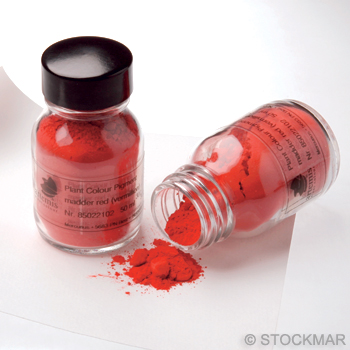de
| en

Pigments from natural dyes 1.7 fl. oz.
Art.: 221--
made in Germany
jar each 50 ml, 15 colours available
Powder to be mixed with binding agent.
Natural dyes are fluid substances extracted from colour-yielding plants that have been precipitated with aluminium oxide.
Typical watercouloring techniques like transparent painting and layering let the colours of natural dyes appear especially bright and shiny. Natural dyes also increase one's awareness of colour harmony.
Colours: Depending on the harvest, climate and other environmental influences, subtle differences in colour may occur.
The relationship content (weight in gram) to
bottle size in fl. oz you can see in the following table:
**The raw material of the colour gum-gutti (golden yellow) is used in veterinary medicine and must be classed as "slightly poisonous". Therefore it is not suitable for children.
Natural dyes are fluid substances extracted from colour-yielding plants that have been precipitated with aluminium oxide.
Typical watercouloring techniques like transparent painting and layering let the colours of natural dyes appear especially bright and shiny. Natural dyes also increase one's awareness of colour harmony.
Colours: Depending on the harvest, climate and other environmental influences, subtle differences in colour may occur.
The relationship content (weight in gram) to
bottle size in fl. oz you can see in the following table:
| colour-no. | 0.34 fl. oz. | 1.7 fl. oz. | 5.1 fl. oz. |
| 01, 31 | 8 g | 40 g | 120 g |
| 02, 04, 05 | 6 g | 30 g | 90 g |
| 03, 11, 14, 30 | - | 30 g | - |
| 09, 35 | 5 g | 25 g | 75 g |
| 07, 34 | 3 g | 20 g | 60 g |
| 12 | - | 14 g | - |
| 15 | - | 20 g | - |
**The raw material of the colour gum-gutti (golden yellow) is used in veterinary medicine and must be classed as "slightly poisonous". Therefore it is not suitable for children.
| Art. | colour | |
| 22111 | alkanet red | |
| 22112 | brazil wood (purple) | |
| 22104 | buckthorn berries (golden yellow) | |
| 22101 | carmine red | |
| 22114 | cutch brown | |
| 22134 | gum-gutti (golden yellow)** | |
| 22109 | indigo blue | |
| 22135 | indigo purple | |
| 22103 | kamala orange | |
| 22107 | leafgreen | |
| 22115 | logwood black | |
| 22131 | madder red (pure) | |
| 22105 | mignonette (lemon yellow) | |
| 22102 | vermilion | |
| 22130 | walnut (brown) |